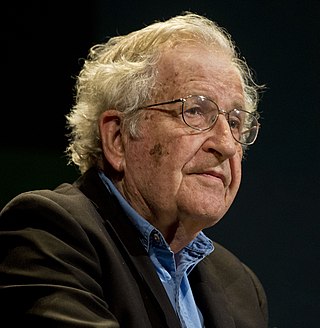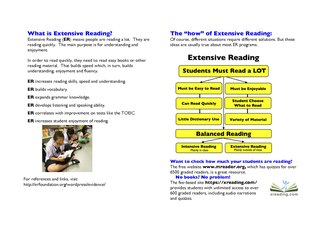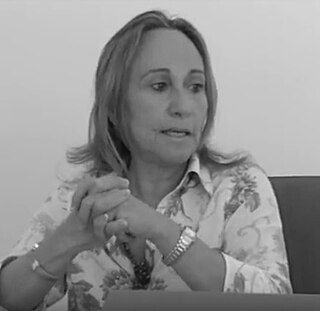Related Research Articles
Language acquisition is the process by which humans acquire the capacity to perceive and comprehend language, as well as to produce and use words and sentences to communicate.

Universal grammar (UG), in modern linguistics, is the theory of the innate biological component of the language faculty, usually credited to Noam Chomsky. The basic postulate of UG is that there are innate constraints on what the grammar of a possible human language could be. When linguistic stimuli are received in the course of language acquisition, children then adopt specific syntactic rules that conform to UG. The advocates of this theory emphasize and partially rely on the poverty of the stimulus (POS) argument and the existence of some universal properties of natural human languages. However, the latter has not been firmly established, as some linguists have argued languages are so diverse that such universality is rare. It is a matter of empirical investigation to determine precisely what properties are universal and what linguistic capacities are innate.
Cognitive linguistics is an interdisciplinary branch of linguistics, combining knowledge and research from cognitive science, cognitive psychology, neuropsychology and linguistics. Models and theoretical accounts of cognitive linguistics are considered as psychologically real, and research in cognitive linguistics aims to help understand cognition in general and is seen as a road into the human mind.
A heritage language is a minority language learned by its speakers at home as children, and difficult to be fully developed because of insufficient input from the social environment. The speakers grow up with a different dominant language in which they become more competent. Polinsky and Kagan label it as a continuum that ranges from fluent speakers to barely-speaking individuals of the home language. In some countries or cultures which determine a person's mother tongue by the ethnic group they belong to, a heritage language would be linked to the native language.
Second-language acquisition (SLA), sometimes called second-language learning — otherwise referred to as L2acquisition, is the process by which people learn a second language. Second-language acquisition is also the scientific discipline devoted to studying that process. The field of second-language acquisition is regarded by some but not everybody as a sub-discipline of applied linguistics but also receives research attention from a variety of other disciplines, such as psychology and education.

Multilingualism is the use of more than one language, either by an individual speaker or by a group of speakers. It is believed that multilingual speakers outnumber monolingual speakers in the world's population. More than half of all Europeans claim to speak at least one language other than their mother tongue; but many read and write in one language. Multilingualism is advantageous for people wanting to participate in trade, globalization and cultural openness. Owing to the ease of access to information facilitated by the Internet, individuals' exposure to multiple languages has become increasingly possible. People who speak several languages are also called polyglots.
Language development in humans is a process starting early in life. Infants start without knowing a language, yet by 10 months, babies can distinguish speech sounds and engage in babbling. Some research has shown that the earliest learning begins in utero when the fetus starts to recognize the sounds and speech patterns of its mother's voice and differentiate them from other sounds after birth.
In the field of psychology, nativism is the view that certain skills or abilities are "native" or hard-wired into the brain at birth. This is in contrast to the "blank slate" or tabula rasa view, which states that the brain has inborn capabilities for learning from the environment but does not contain content such as innate beliefs. This factor contributes to the ongoing nature versus nurture dispute, one borne from the current difficulty of reverse engineering the subconscious operations of the brain, especially the human brain.
The critical period hypothesis or sensitive period hypothesis claims that there is an ideal time window of brain development to acquire language in a linguistically rich environment, after which further language acquisition becomes much more difficult and effortful. It is the subject of a long-standing debate in linguistics and language acquisition over the extent to which the ability to acquire language is biologically linked to age. The critical period hypothesis was first proposed by Montreal neurologist Wilder Penfield and co-author Lamar Roberts in their 1959 book Speech and Brain Mechanisms, and was popularized by Eric Lenneberg in 1967 with Biological Foundations of Language.

Fluency is the property of a person or of a system that delivers information quickly and with expertise.
In linguistics, the innateness hypothesis holds that humans are born with at least some knowledge of linguistic structure. On this hypothesis, language acquisition involves filling in the details of an innate blueprint rather than being an entirely inductive process. The hypothesis is one of the cornerstones of generative grammar and related approaches in linguistics. Arguments in favour include the poverty of the stimulus, the universality of language acquisition, as well as experimental studies on learning and learnability. However, these arguments have been criticized, and the hypothesis is widely rejected in other traditions such as usage-based linguistics. The term was coined by Hilary Putnam in reference to the views of Noam Chomsky.

Extensive Reading (ER) is the process of reading longer easier texts for an extended period of time without a breakdown of comprehension, feeling overwhelmed, or the need to take breaks. It stands in contrast to intensive or academic reading, which is focused on a close reading of dense shorter texts, typically not read for pleasure. Though used as a teaching strategy to promote second-language development, ER also applies to free voluntary reading and recreational reading both in and out of the classroom. ER is based on the assumption that we learn to read by reading.
Heritage language learning, or heritage language acquisition, is the act of learning a heritage language from an ethnolinguistic group that traditionally speaks the language, or from those whose family historically spoke the language. According to a commonly accepted definition by Valdés, heritage languages are generally minority languages in society and are typically learned at home during childhood. When a heritage language learner grows up in an environment with a dominant language that is different from their heritage language, the learner appears to be more competent in the dominant language and often feels more comfortable speaking in that language. "Heritage language" may also be referred to as "community language," "home language," and "ancestral language".
The order of acquisition is a concept in language acquisition describing the specific order in which all language learners acquire the grammatical features of their first language. This concept is based on the observation that all children acquire their first language in a fixed, universal order, regardless of the specific grammatical structure of the language they learn. Linguistic research has largely confirmed that this phenomenon is true for first-language learners; order of acquisition for second-language learners is much less consistent. It is not clear why the order differs for second-language learners, though current research suggests this variability may stem from first-language interference or general cognitive interference from nonlinguistic mental faculties.
The main purpose of theories of second-language acquisition (SLA) is to shed light on how people who already know one language learn a second language. The field of second-language acquisition involves various contributions, such as linguistics, sociolinguistics, psychology, cognitive science, neuroscience, and education. These multiple fields in second-language acquisition can be grouped as four major research strands: (a) linguistic dimensions of SLA, (b) cognitive dimensions of SLA, (c) socio-cultural dimensions of SLA, and (d) instructional dimensions of SLA. While the orientation of each research strand is distinct, they are in common in that they can guide us to find helpful condition to facilitate successful language learning. Acknowledging the contributions of each perspective and the interdisciplinarity between each field, more and more second language researchers are now trying to have a bigger lens on examining the complexities of second language acquisition.
The interaction hypothesis is a theory of second-language acquisition which states that the development of language proficiency is promoted by face-to-face interaction and communication. Its main focus is on the role of input, interaction, and output in second language acquisition. It posits that the level of language that a learner is exposed to must be such that the learner is able to comprehend it, and that a learner modifying their speech so as to make it comprehensible facilitates their ability to acquire the language in question. The idea existed in the 1980s, and has been reviewed and expanded upon by a number of other scholars but is usually credited to Michael Long.
Carmen Silva-Corvalán is a Professor Emerita of Spanish and Portuguese Linguistics at the University of Southern California, where she taught since she obtained her doctoral degree at the University of California, Los Angeles in 1979. Silva-Corvalán has published extensively on bilingualism and language contact, and on the semantic and discourse-pragmatic constraints which condition syntactic variation. Silva-Corvalan was one of the four chief editors of Bilingualism: Language and Cognition, Cambridge University Press.
Complex Dynamic Systems Theory in the field of linguistics is a perspective and approach to the study of second, third and additional language acquisition. The general term Complex Dynamic Systems Theory was recommended by Kees de Bot to refer to both Complexity theory and Dynamic systems theory.

Rosa María Manchón Ruiz is a Spanish linguist. She is currently a professor of applied linguistics at the University of Murcia, Spain. Her research focuses on second language acquisition and second language writing. She was the editor of the Journal of Second Language Writing between 2008 and 2014.
Suzanne Flynn is an American linguist and Professor of Linguistics at MIT who has contributed to the fields of second and third language acquisition. She has also investigated language disorders.
References
- ↑ Williams S, Hammarberg B (1998). "Language switches in L3 production: Implications for a polyglot speaking model". Applied Linguistics. 19 (3): 259–333. doi:10.1093/applin/19.3.295.
- 1 2 Bardel, Camilla; Sánchez, Laura (2020). Third language acquisition (pdf). Berlin: Language Science Press. doi: 10.5281/zenodo.4138753 . ISBN 978-3-96110-281-5.